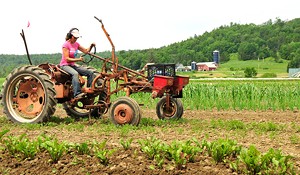Published July 20, 2011 at 10:28 a.m.
The narrow dirt drive leading to Wellspring Farm is choked with parked cars. It’s farm share pick-up day, and folks have come to collect their bounty. One of those cars belongs to Barbara Dall, who lives in Montpelier. She has driven the 12 miles to Marshfield, just as she’s done every Monday during growing season for the past four years, to collect her vegetables.
Upon arrival, Dall heads straight to the farm’s prim fields, bypassing the open-air shed that holds the bulk of that day’s vegetable share. With purpose, she hikes the short track up to the rows of sugar snap peas, which are jewel-tone green and ready for picking. Dall bends to reach the peas, and they pop off their vines with ease. She fills her plastic bag with a quart of sugar snaps before moving on to a row of hearty basil. Dall plucks the plants from the earth and counts the leaves — 22, to be exact. Perfect for a homemade tomato-basil pizza, with enough left over for some pesto. She looks pleased.
Dall walks back toward the cars, past fields of blooming broccoli and febrile chard — the temperature has crested in the high 80s. On her way to the shed, she stops to chat with farmer Mimi Arnstein about her culinary plans for the basil. Then Dall picks up the rest of her CSA, or community-supported agriculture, share. She loads up on zucchini, new potatoes, scallions, fresh garlic and salad greens. Herbie Hancock plays on the small boom box in the shed.
When she leaves, Dall seems happy, nearly glowing, though that could just be the sun. Mondays are special for her, she says. It’s the day she can get a little dirty and participate in her local agricultural community.
“I think it’s the best thing in the world,” Dall gushes, when asked about her Wellspring Farm CSA. “I know exactly where my meals are coming from. And I get to be talking to my farmer and have the whole experience. I get recipes, and I get my questions answered. I think it’s just perfect.”
When Arnstein, who has been running Wellspring Farm since 2003, hears her members effervesce about her operation, she can’t help but beam. Fostering a sense of community with her members is one of her most pressing objectives as a farmer. Sure, she wants to grow good-looking radishes and cucumbers and responsibly steward the land. But equally important is connecting with CSA members.
“We’re not just growing vegetables; we’re building community,” Arnstein says.
Her certified organic operation is the very definition of community-supported agriculture. Not only are Arnstein’s 138 member families supporting the farm by providing much-needed cash flow in advance of the growing season, but they’re also participating in the process of growing food by harvesting some of the more labor-intensive vegetables as well as herbs and flowers, for themselves.
Her niche in the expanding CSA marketplace, Arnstein says, is the “on-farm experience.” Pick-up days have a festive air. Members share recipes and cooking tips. Children play in the toy-filled sandbox. The act of farming is visible all around. Arnstein and her farm staff chat with members and get acquainted with their families. To wit, she knows every member by name.
While Wellspring Farm’s CSA may be the gold standard of local agriculture models, it’s not the only way to operate. Increasingly, as the number of CSAs around the state expands, so does the notion of just what a CSA is.
Arnstein’s farm has clearly been successful at engaging its community in a meaningful way, and her model works for its members. But, for farms setting up new CSAs, it’s no longer enough just to offer a scheduled pick up of specific items. Farms have to get creative as competition for CSA consumers grows. Each year, about 20 new CSAs enter the marketplace in Vermont.
To stand out, farms with CSAs must differentiate themselves by offering services that other farms don’t, from selling debit-like cards that members can use at farmers markets to offering members a chance to select their produce à la carte online. Some CSAs feature add-ons with products such as maple syrup and cheese. Others offer modest shares for single folks or couples. Still others provide year-round options that come as close to encompassing a full diet as possible. In many parts of the country, just selling CSA shares would set a farm apart. But for CSA farmers in Vermont, providing a niche service is increasingly essential.
Community-supported agriculture first emerged in the 1960s concurrently in Japan and Europe. Farmers began selling shares of their business early in the season in exchange for weekly boxes of mixed produce that shareholders picked up on the farm or at a drop-off location. The direct sales helped stabilize farmers’ incomes and support sustainable growing practices, as well as buttress the farms against crop failure. With CSAs, the growers and the consumers shared the risks and rewards of farming. And, says Beth Holtzman, outreach coordinator for the University of Vermont Extension’s New Farmer Project, CSAs “allow [the farmer] to focus more on growing during the growing season.”
The CSA model took root in the United States in the mid-1980s, when a Swiss farmer named Jan Vander Tuin introduced the concept to a farm in Massachusetts. Since then, the model’s popularity has exploded in this country: There are now close to 13,000 CSAs in operation nationwide, according to the 2007 USDA Census of Agriculture.
While CSA is a smart model for many smaller-scale, diversified farms, it’s also a good deal for consumers. They get access to fresh, local produce (and, increasingly, meats, milk, cheese and other value-added ag products) while establishing a connection to the land and the people who farm it. CSA consumers typically also get a deal in terms of cost. Farm shares tend to offer a 10 to 20 percent savings over retail markets. Arnstein, of Wellspring Farm, provides a weekly breakdown of the shares’ value to her members, who on average see a 12 percent savings over retail, she says.
Vermont has long been at the apex of direct agricultural product sales and currently leads the nation in that category, with $36.77 spent annually per capita at farm stands, farmers markets and CSAs. Since 2000, the number of CSAs in Vermont has grown by 500 percent, according to the Northeast Organic Farming Association of Vermont. At present, NOFA-VT estimates, more than 120 CSAs are operating in the state.
In the 2007 USDA Census, 165 Vermont farms reported marketing products through community-supported agriculture, though not all of those farms run their own CSAs. That’s more than in Connecticut, Maine, New Hampshire and 18 other states. With such a sparsely populated state showing numbers like that, it may seem that Vermont has reached a CSA saturation point. But Jean Hamilton, food security and marketing coordinator for NOFA-VT, insists it hasn’t.
“I think it’s really important that we regularly pick our heads up off the ground and say, yes, there are over 100 CSAs and more and more farmers markets every day, but at the same time, we’re just a tiny, tiny fraction of the food market in Vermont,” she says. “The nice thing about CSA as a concept is it’s pretty nimble and flexible, and there’s lots of diversity that’s moving farms in different ways.”
The number of CSA permutations on offer in Vermont these days is mind boggling. Perhaps the best known is Pete’s Greens in Craftsbury, a successful and sprawling operation that distributes a broad range of shares throughout Chittenden, Lamoille, Orleans and Washington counties. Its Localvore Share combines produce from the farm with value-added goods from area producers.
Then there’s the workplace model, such as the CSA offered by the Rutland Area Farm & Food Link (RAFFL), which provides shares to employees of large area businesses. Some farms, such as the year-old Freedom and Unity Farm in Richmond, offer members 110 percent of their investment in store credit to use at the farm stand, in lieu of a set box of produce every week.
Tangletown Farm in Middlesex provides shares of meat such as rabbit, guinea fowl and pheasant, while Bread & Butter Farm in South Burlington, though not a full-service CSA, offers raw-milk shares. Some CSAs, such as yourfarmstand.com, aren’t associated with any particular farm and operate only online. And some Vermont farms even operate out-of-state CSAs. Holton Farms in Westminster, one of the larger CSA operations in the state, serves CSA members in the New York City area exclusively.
“I’m constantly in awe of the creativity in the farming community,” says the New Farmer Project’s Holtzman. “I like to think we help with that.”
Mimi Arnstein came to farming in her late twenties after having a life-changing experience at an organic farm outside Boston. She had volunteered to help harvest, and as she picked tomatoes, she became overwhelmed by the sensory experience of farming. The feel of the hot sun on her skin, the smell of the loamy earth beneath her feet and the sensation of the silky tomato in her hand all helped set in motion a drastic life change. Arnstein, who was working in academic affairs at a university at the time, continued volunteering at that farm and later moved to Vermont to apprentice at Intervale Community Farm.
She acknowledges she’s perhaps a bit overly romantic about farm life. But, says the 38-year-old, it’s part of what makes her job possible.
“You need the romance and the dream, because [farming] is hard,” she says.
The petite, 5-foot-tall Arnstein is a spitfire of energy. During a recent Monday pick up, she talks to every member she sees.
“Hey, Barb! How’s the picking?” she asks longtime member Dall.
“It’s great,” Dall responds, her hands laden with produce.
For Arnstein, this is exactly what CSA farming should be about — personal connection. It’s what initially sparked her desire to farm.
“One of the reasons I’m so interested in having a farm like this is because this is how agriculture changed my life,” she says. “I crave connection, and this is the way I get it.”
Arnstein chose to run a traditional CSA because she would rather spend her time feeding her community than shipping produce and dealing with retail markets. But it isn’t so easy to sell a CSA share, especially in a rural area where most residents have significantly less disposable income than those in cities and towns.
This year, for the first time since she’s been running the farm, Arnstein lost members, down from 160 last year. The average turnover rate for CSAs is 30 percent. Arnstein attributes the attrition to an anemic economy and the fact that more people have taken up gardening and don’t need a share. Some just wanted to try a new farm.
Regularly, Arnstein surveys her members to determine why they’ve joined and what they’re interested in seeing from their CSA. To the first inquiry, most people respond that they want to know their farmer and support local agriculture. But Arnstein suspects that just as important, if not more so, is members’ sense that they’re getting some sort of deal. By giving away surplus produce, providing recipes and offering incentives for current members to bring in new ones, Arnstein tries to make her CSA worth their money.
But Arnstein’s farm isn’t for everyone. Not every CSA customer needs or wants to feel like part of a farm community. Nor can everyone use the generous amount of product that comes in a Wellspring share. That’s why Amie Francoeur and her partner, Jen Miller, started Samara Farm, a small-share, certified organic CSA and the Intervale’s newest agricultural venture.
Francoeur and Miller, both 29, previously worked on farms with large CSAs, including Intervale Community Farm and Jericho Settlers’ Farm. At those farms, the pair learned how to run a traditional CSA, but when they decided to strike out on their own, they made theirs a little different.
“We wanted to make food more affordable by doing smaller shares,” says Francoeur, a soft-spoken woman with a bright smile.
After talking with some friends, she and Miller discovered a need that current CSAs weren’t satisfying. Single people and couples without children said they’d be interested in a CSA if it weren’t for the expense and the quantity of produce. Those who did have such CSAs complained that they couldn’t use the vegetables they received, either because the share was too big or because they didn’t know how to prepare more exotic products, such as kohlrabi.
“We wanted to create a new share idea for people who can’t afford $400 shares but want a CSA and want to be part of a farm,” Miller says. Samara Farm’s summer shares cost $275 each.
Miller and Francoeur also reasoned that setting themselves apart from the standard CSA was essential in order to succeed. Otherwise, why would anyone choose their unproven farm share over an established CSA?
Through aggressive grassroots marketing and word of mouth, the couple signed up new members that fit their target demographic. They exceeded their goal of 75 and now have 81 members. Half of them never had a CSA before, and many are couples with children who are using the Samara share as a supplement. Four are working members who get summer and winter shares in exchange for five hours of sweat equity per week on the farm.
On a recent weekday, worker-member Heather Reed helps Francoeur and Miller weed rows of potatoes. Because, like many farmers at the Intervale, their fields flooded in the early part of the season, the pair had to replant many of their vegetables. As a result, they got off to a slow start. The weeds are ahead of them in places, so an extra set of hands is welcome.
So far, Samara’s small-share CSA seems to be a success. Members are happy, and a number of them have volunteered at the farm and participated in on-farm events such as seeding and onion-planting parties.
For those who don’t care to get their hands dirty, multifarm operations such as the Intervale Food Hub offer farm-fresh produce delivered to their workplace, no pick up or buy-in required. For that convenience, Food Hub members tend to pay a little more than traditional CSA members do — the basic summer vegetable shares cost $550; with add-ons they can run up to $925. But for people who value their time above all else, the solution is perfect.
The Intervale Food Hub began as a research project of the Intervale Center and the UVM Center for Rural Studies in 2007, which examined the barriers to CSA participation among Chittenden County households. At the time, says Food Hub director Sona Desai, 4 percent of survey respondents in the county had CSA shares. Of those who didn’t, 38 percent said they would like to have a farm share if it were more accessible.
“It seemed like there was a demand, if we could make it convenient,” Desai says.
When the Food Hub officially launched in 2008, the goal was not to compete with existing CSAs. So, like RAFFL in Rutland County, the Hub went for an untapped market in the area — workplaces. Staffers contacted larger employers, including GE Healthcare, Vermont Student Assistance Corporation and Dealer.com, and offered farm shares to employees. Eighty-five percent of those who joined the Food Hub in its first year had never participated in a CSA.
Unlike single-farm shares, such as those of Wellspring or Samara, shares from the Food Hub contain products from 22 different producers. Its 325 members might get maple syrup from Dragonfly Sugarworks in Huntington, salad greens from Hazendale Farm in Greensboro, cheese from the Mount Mansfield Creamery in Morrisville or butternut squash from Rockville Market Farm in Starksboro, depending on which share they buy. This variety can be appealing to people who feel constrained by traditional produce shares.
The Food Hub model isn’t just good for busy consumers. It saves its producers from having to grow 40 different crops or manage a CSA membership (though some of the farms do operate their own CSAs). Nor do they have to organize pick-up boxes or deal with member problems. That’s Desai’s job. For farmers, the Food Hub works like a guaranteed wholesale market, except that the price they get for their products is slightly higher.
Since 2008, the Food Hub has grown by 65 percent annually. That’s an aggressive growth curve, says Desai, and one that she hopes will continue as the Hub, which currently serves mostly Burlington workplaces, pushes out into areas such as Shelburne and Williston. Eventually, Desai says, she would like to see the Food Hub become farmer owned.
Despite its dramatic growth, Desai, a former farmer, believes the Food Hub is not trampling on smaller CSAs such as Samara, its Intervale neighbor. On the contrary, she suggests, it’s providing these farms with new customers by turning people on to the CSA concept. A handful of Food Hub members leave after their first year to take part in traditional farm shares. Desai thinks there’s room for her operation and CSAs such as Wellspring or Samara to coexist.
“I don’t think we have saturated the marketplace,” she says. “But you have to be more creative. Convenience, like it or not, has to be a part of it.”
As the CSA model continues to grow to meet the needs of consumers, so will its importance in the local food system. In Vermont’s new Farm to Plate Strategic Plan, a 10-year initiative to shore up and expand the state’s food system, CSAs play a critical role in achieving one of the key objectives: getting more Vermonters to consume locally produced food.
“We need to encourage CSAs to continue,” says Erica Campbell, program director for the Farm to Plate initiative, a collaborative project spearheaded by the Vermont Sustainable Jobs Fund. “That may mean supporting them with marketing, distribution or other needs. I think it’s a great model for farmers to connect with consumers.”
In the future, Campbell guesses the CSA model will expand to include more à la carte operations and online brokerage sites that allow consumers access to a wide selection of Vermont products. And, ideally, some of the medium-sized farm operations will scale up to meet the demands of larger retail and wholesale markets through pre-buy contracts similar to the CSA model.
But, no matter how the CSA model changes, farms like Wellspring that offer consumers a close connection to the land and the people who farm it will always be attractive. Perhaps not to everyone, but certainly to people who want to participate in their local agricultural community and don’t mind getting a little dirty.
More By This Author
Speaking of Localvore Movement
-

A Produce Buyer Weighs in on Local Options for Winter Eating
Jan 29, 2014 -

South End Kitchen to Open This Week
Jan 21, 2014 -

Start-up Stowe Cider is Thriving
Dec 11, 2013 -
Sterling College Introduces Artisan Cheesemaking Intensive
Dec 4, 2013 -

A Hydroponic Farm Makes Vermont Winters Tastier
Oct 9, 2013 - More »
Comments
Comments are closed.
From 2014-2020, Seven Days allowed readers to comment on all stories posted on our website. While we've appreciated the suggestions and insights, right now Seven Days is prioritizing our core mission — producing high-quality, responsible local journalism — over moderating online debates between readers.
To criticize, correct or praise our reporting, please send us a letter to the editor or send us a tip. We’ll check it out and report the results.
Online comments may return when we have better tech tools for managing them. Thanks for reading.














































